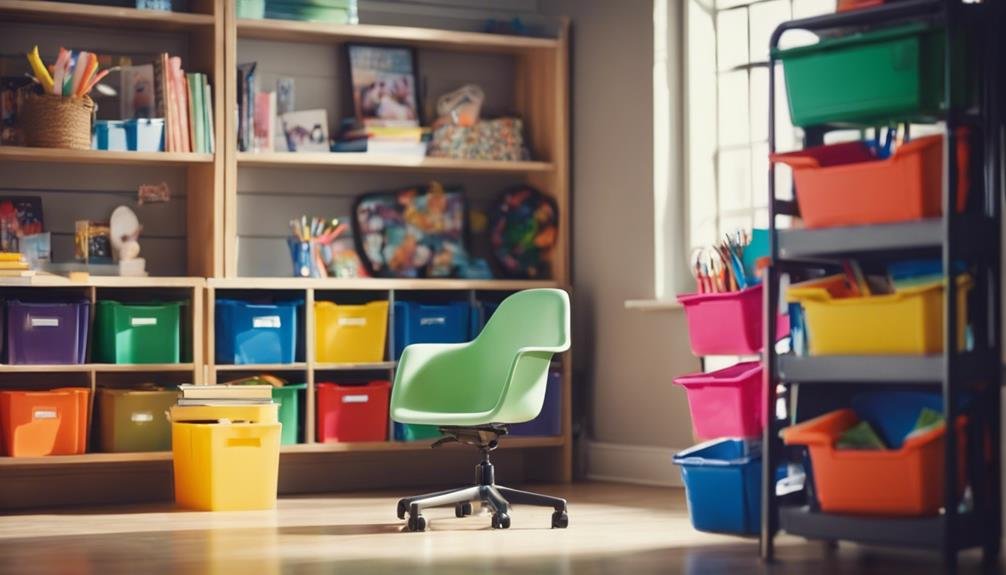"Cherishing Little Steps - A Haven for Baby and Family Journeys"
Tips for Creating an Effective Study Space for Young Learners
Imagine transforming a regular room into a haven for focused learning – a place where young minds can thrive. But how can you guarantee the perfect study space that enhances concentration and productivity?
By carefully considering factors like lighting, organization, and comfort, you can set the stage for effective studying.
So, what are the key elements that will make this space truly conducive to learning?
Key Takeaways
- Minimize distractions and clutter to enhance focus and productivity.
- Provide comfortable seating options for flexibility and ergonomic support.
- Utilize storage solutions for organization and tidiness.
- Encourage movement and breaks to boost energy and concentration.
Minimize Distractions

To create an effective study space for young learners, guarantee distractions are minimized by eliminating clutter and setting up a designated area specifically for studying. A clear desk is crucial, providing a focused environment for academic tasks. Assure the desk is organized with only necessary materials to avoid visual disturbances. Incorporate calming colors into the study space to promote concentration and relaxation. Soft blues, greens, or pastel shades can create a soothing ambiance conducive to learning.
Introduce noise canceling headphones to block out external sounds that may disrupt concentration. These headphones can help young learners maintain focus in a busy household or noisy environment. Additionally, consider providing fidget toys to channel excess energy and improve attention during study sessions. Fidget toys can enhance cognitive performance by offering a tactile outlet for restlessness without being overly distracting.
Choose Appropriate Lighting
Consider adjusting the lighting in the study space to optimize focus and reduce eye strain for young learners. Proper lighting can greatly impact a child's ability to concentrate and study effectively. When setting up the lighting for your young learner's study area, keep the following tips in mind:
- Natural vs. artificial lighting: Natural light is ideal for studying as it mimics the brightness and color temperature of daylight, which can help improve mood and alertness. Position the study space near a window to maximize natural light exposure during the day. Additionally, consider adding guaranteed lighting sources for when natural light is insufficient.
- Task lighting options: Task lighting, such as desk lamps or adjustable floor lamps, can provide focused illumination for specific study activities. Make sure that the light source is directed towards the study materials without causing glare or shadows. LED lights are energy-efficient and offer a bright, clear light that's gentle on the eyes.
- Adjustable lighting: Opt for lighting options that allow for adjustment in brightness and direction. This flexibility enables young learners to customize the lighting based on their specific needs and preferences, promoting a comfortable and productive study environment.
Organize Study Materials Effectively

Effectively organizing study materials is a fundamental aspect of creating a conducive learning environment for young learners. Utilizing color coded folders can help young learners categorize and locate their materials with ease. Assigning each subject a specific color can aid in quick identification and retrieval of necessary resources.
Additionally, desk organizers are invaluable tools for keeping study spaces tidy and clutter-free. Pens, pencils, erasers, and other supplies can be neatly arranged within organizers, promoting a sense of orderliness that can enhance focus and productivity.
When setting up the study space, consider incorporating color coded folders for each subject and desk organizers for supplies. This simple yet effective organization system can facilitate better study habits and encourage young learners to take ownership of their academic materials. By implementing these organizational strategies, you can create a structured and efficient study environment that supports learning and boosts productivity.
Incorporate Ergonomic Furniture
Incorporating ergonomic furniture into your young learner's study space can greatly enhance their comfort and overall well-being during study sessions. When setting up their study area, consider the following:
- Adjustable Desks: Opt for desks that can be adjusted to the appropriate height to make sure your child maintains good posture while studying. This helps prevent strain on their neck and back, promoting better focus and reducing the risk of musculoskeletal issues.
- Supportive Chairs: Choose chairs that provide proper lumbar support and are adjustable to your child's height. A supportive chair encourages a healthy sitting posture, reducing fatigue and discomfort during long study sessions.
- Proper Lighting: While not furniture per se, adequate lighting is essential for creating a study environment that's easy on the eyes. Make sure there's ample natural light or invest in a good desk lamp to prevent eye strain and headaches.
Personalize the Study Space

To enhance your young learner's study environment, personalizing the study space with items that reflect their interests and preferences can foster a sense of ownership and motivation. Decorating creatively can involve incorporating elements like posters of their favorite animals, characters from beloved books, or educational charts related to their hobbies. By surrounding them with familiar and comforting visuals, you create a space where they feel comfortable and inspired to engage with their studies.
Personalizing with purpose goes beyond just adding decorations. Consider including items that serve a specific function based on your child's preferences. For instance, if your child enjoys drawing, having a dedicated art corner with their favorite supplies can encourage creativity and make studying more enjoyable. You could also incorporate elements like a cozy reading nook with cushions and a selection of books that align with their interests, making learning feel more like a leisurely activity.
Implement a Reward System
Consider implementing a structured reward system to incentivize and reinforce positive study habits in young learners. Positive reinforcement is a powerful tool in shaping behavior and can notably enhance motivation levels.
Here are three effective ways to implement a reward system:
- Behavior Reinforcement: Use a token system where children earn tokens for completing tasks or exhibiting desired behaviors during study time. These tokens can then be exchanged for rewards, creating a direct link between positive actions and incentives.
- Incentive Programs: Create a tiered reward system where learners can progress through different levels based on their study achievements. Each level can come with increasingly enticing rewards, encouraging students to aim for higher accomplishments.
- Motivation Techniques: Tailor rewards to match the interests and preferences of the individual learner. Personalized incentives can enhance motivation and make the reward system more engaging and effective.
Establish a Study Routine

To establish a productive study routine for young learners, begin by setting consistent daily schedules that align with their natural rhythms and optimize focus. Encouraging good time management practices from a young age can lead to lifelong skills that enhance academic performance. Here are some tips to help you create an effective study routine for your child:
| Tips for Establishing a Study Routine | Description | Benefits |
|---|---|---|
| Consistent Schedule | Set regular study times each day to create a sense of structure and predictability. | Helps young learners develop a habit of studying regularly. |
| Study Buddies | Encourage group study sessions with friends or classmates to facilitate learning through collaboration. | Enhances social interaction and provides support during the learning process. |
| Effective Time Management | Teach your child how to prioritize tasks and allocate time efficiently for each subject. | Improves productivity and prevents procrastination. |
Create a Comfortable Seating Area
Creating a comfortable seating area for young learners is vital to promote focus and engagement during study sessions. To guarantee your child has a cozy and inviting space to learn effectively, consider the following tips:
- Bean Bag Chairs and Floor Pillows: Incorporating bean bag chairs and floor pillows into the study area provides flexible seating options that can accommodate different preferences and postures. These items offer a relaxed and casual seating arrangement that can help children feel at ease while studying.
- Cozy Reading Nook with Soft Cushions: Designating a specific area as a cozy reading nook with soft cushions can create a comforting environment for young learners. Adding plush cushions to a corner or alcove can establish a dedicated space for reading or quiet study time.
- Adjustable Seating Options: Providing adjustable seating options, such as chairs with varying heights or cushions that can be stacked, allows children to customize their seating arrangement for maximum comfort and support during long study sessions. This adaptability can help prevent discomfort and promote better focus.
Utilize Storage Solutions

Utilize storage solutions efficiently to organize study materials and enhance your young learner's productivity in their designated study space. Space optimization is important in creating an environment that fosters concentration and learning. Implement decluttering techniques such as using bins, shelves, and drawer organizers to keep the study area tidy and free of distractions.
Creative storage solutions like wall-mounted shelves, hanging organizers, and under-desk compartments can maximize space utilization while keeping essential items easily accessible.
Consider incorporating hidden compartments in furniture pieces like desks or bookshelves to store supplies discreetly and maintain a clean aesthetic. By strategically placing storage solutions around the study space, you can encourage your young learner to stay organized and focused during study sessions.
Teaching them the importance of tidiness and providing them with the tools to maintain an orderly environment will promote a sense of responsibility and independence in their academic pursuits. Remember, a well-organized study space can have a significant impact on your child's learning experience and overall productivity.
Encourage Breaks and Movement
Efficiently managing study breaks and incorporating movement into your young learner's routine can greatly enhance their focus and overall productivity in their designated study space. Encouraging breaks that involve physical activity can help keep your child engaged and alert throughout their study sessions. Here are some tips to incorporate active breaks and movement into your young learner's study space:
- Active breaks: Encourage your child to take short breaks where they can engage in activities like stretching or jumping jacks. These movements can help release tension and improve blood flow, ultimately boosting their concentration levels.
- Movement breaks: Consider incorporating movement breaks that involve dancing or simple exercises. Movement breaks not only provide a physical outlet but also stimulate the brain, making it easier for your child to retain information and stay focused.
- Outdoor breaks: Whenever possible, encourage your child to take their breaks outside. Fresh air and natural surroundings can have a rejuvenating effect, helping your child recharge and return to their study space with renewed energy.
Frequently Asked Questions
How Can I Create a Study Space That Caters to Children With Special Needs or Learning Disabilities?
To create a study space for children with special needs or learning disabilities, consider sensory-friendly furniture, lighting options, quiet study zones, and organization tools. These elements can help provide a comfortable and conducive environment for effective learning.
What Are Some Creative Ways to Make the Study Space More Engaging and Interactive for Young Learners?
To make your study space more engaging and interactive, incorporate visual aids and hands-on activities. Research shows that interactive learning increases retention by 75%. Use colorful posters, educational games, and tactile materials to enhance learning experiences.
How Can I Incorporate Technology Into the Study Space Without It Becoming a Distraction?
To strike the right balance, integrate technology thoughtfully into your study space. Choose digital tools that enhance focus and learning. assure harmony in your environment by setting boundaries and using tech to boost productivity, not distract.
Are There Any Specific Color Schemes or Decor Choices That Can Enhance a Child's Focus and Productivity in the Study Space?
To enhance your child's focus and productivity in the study environment, consider using color psychology to choose calming hues like blue or green. Incorporate decor aesthetics such as plants or inspirational quotes for productivity enhancement.
How Can I Involve My Child in the Process of Designing and Setting up Their Study Space to Ensure They Feel Ownership and Motivation to Use It Effectively?
Like a warm hug, involving your child in designing their study space fosters a sense of ownership and motivation. Collaborate on layout and decor choices. Personalize organization systems. Choose motivational decor together, ensuring a space they love.
Conclusion
To summarize, creating an effective study space for young learners is essential for their academic success. By minimizing distractions, choosing appropriate lighting, organizing study materials effectively, and incorporating ergonomic furniture, you can set them up for productive study sessions.
Remember, Rome wasn't built in a day, so take the time to personalize the study space to meet their needs and encourage a routine that promotes focus and concentration.
Happy studying!


